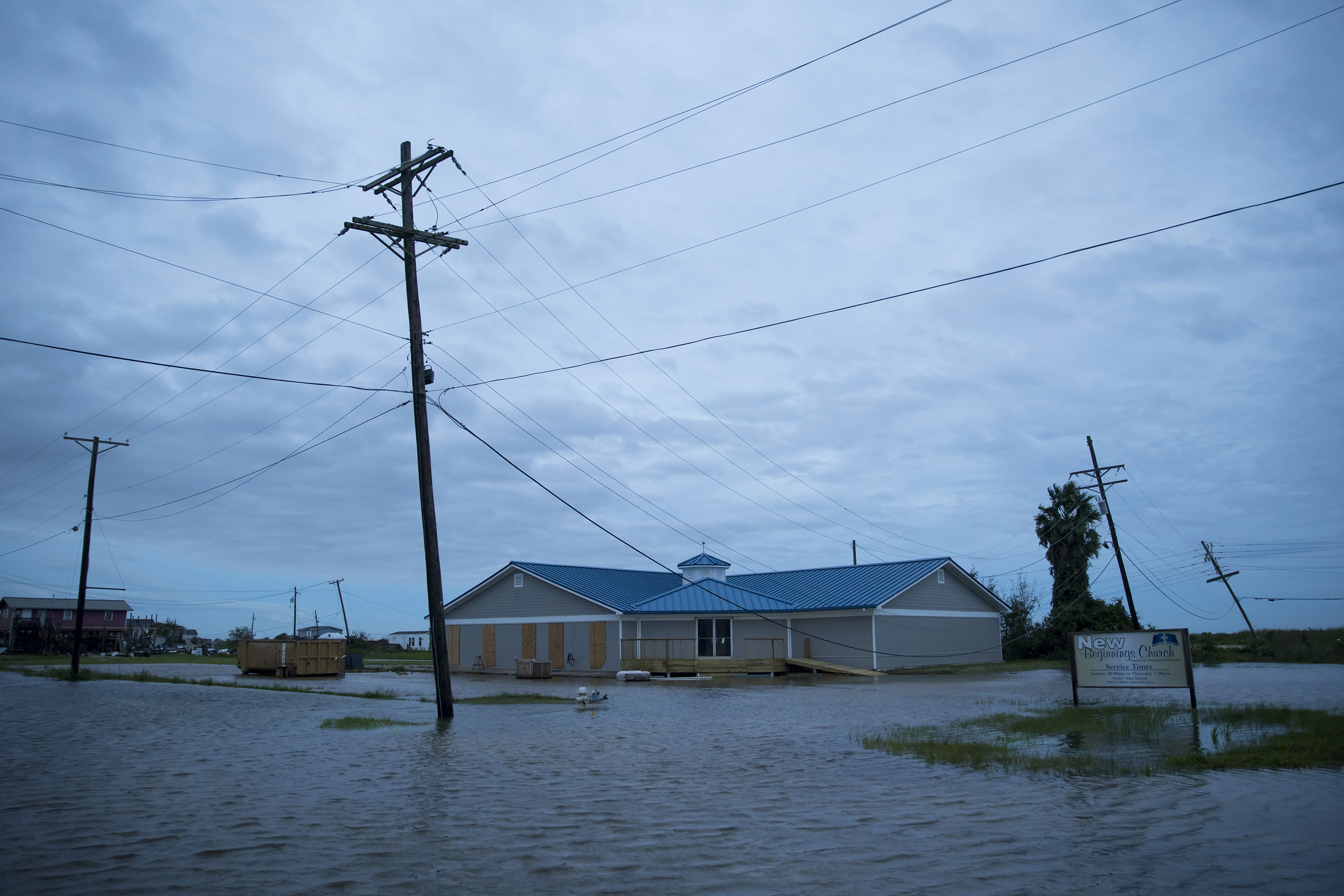By Jesus Jimenez
Tribune News Service
Hurricane Laura roared ashore just east of the Texas border in southeastern Louisiana early Thursday, and hours later the storm was pounding the Gulf Coast with ferocious wind, torrential rains and rising seawater, threatening the lives of people who didn’t evacuate.
Authorities had ordered coastal residents to get out, but not everyone did in an area devastated by Hurricane Rita in 2005.
Howling winds from Laura — since downgraded to Category 2 — battered a tall building in Lake Charles, blowing out windows as glass as debris flew to the ground.
Hours after landfall, the wind and rain were still blowing hard.
“There are some people still in town and people are calling … but there ain’t no way to get to them,” Tony Guillory, president of the Calcasieu Parish Police Jury, said early Thursday morning over the phone as he hunkered down in a Lake Charles government building that was shaking from the storm.
Guillory said he hopes stranded people can be rescued later Thursday but fears that blocked roads, downed power lines and flooding could get in the way. Officials said search missions and damage assessments would begin when conditions allow it.
With more than 290,000 homes and businesses without power in the two states, near-constant lightning provided the only light for some.
The National Hurricane Center said Laura slammed the coast with winds of 150 mph at 1 a.m. as a Category 4 hurricane near Cameron, a 400-person community about 30 miles east of the Texas border. Laura’s strength marked it as the strongest hurricane in the Gulf of Mexico since Hurricane Katrina.
“Unsurvivable storm surge with large and destructive waves will cause catastrophic damage,” forecasters warned.
They said the storm surge could reach 15-20 feet in Port Arthur, Texas, and a stretch of Louisiana including Lake Charles.
“This surge could penetrate up to 40 miles inland from the immediate coastline, and floodwaters will not fully recede for several days,” the hurricane center said.
Hours after landfall, Laura was still a Category 2 hurricane, with maximum sustained winds of 100 mph. Its center was past Lake Charles, moving north at about 15 mph, but with damaging winds that stretched over much of Louisiana and parts of eastern Texas.
Gov. Greg Abbott will travel to East Texas on Thursday to meet with local officials and survey damage, according to his spokesman John Wittman.
More than 580,000 coastal residents were ordered to join the largest evacuation since the coronavirus pandemic began and many did, filling hotels and sleeping in cars since officials didn’t want to open mass shelters and worsen the spread of COVID-19.
But in Cameron Parish, where Laura came ashore, officials said at least 150 people refused pleas to leave and planned to weather the storm in everything from elevated homes to recreational vehicles. The result could be deadly since forecasters said the parish could be completely covered by ocean water.
“It’s a very sad situation,” said Ashley Buller, assistant director of emergency preparedness. “We did everything we could to encourage them to leave.”
Becky Clements, 56, didn’t take chances; she evacuated from Lake Charles after hearing it could take a direct hit. With memories of the destruction almost 15 years ago by Hurricane Rita, she and her family found an Airbnb hundreds of miles inland.
“The devastation afterward in our town and that whole corner of the state was just awful,” Clements recalled Wednesday. “Whole communities were washed away, never to exist again.”
Forecasters expected a weakened Laura to cause widespread flash flooding in states far from the coast. After turning eastward and reaching the Atlantic Ocean, it could again become a tropical storm and threaten the Northeast.
Laura hit the U.S. after killing nearly two dozen people on the island of Hispaniola, including 20 in Haiti and three in the Dominican Republic, where it knocked out power and caused intense flooding.
Laura was the seventh named storm to strike the U.S. this year, setting a new record for U.S. landfalls by the end of August. The old record was six in 1886 and 1916, according to Colorado State University hurricane researcher Phil Klotzbach.
Laura appears to have spared the Houston and Galveston region from any major problems so far. The area can expect winds up to 57 mph from the storm, the National Hurricane Center says.
Ahead of the storm, Galveston County Judge Mark Henry had issued evacuation orders for the area. Harris County Judge Lina Hidalgo had issued a voluntary evacuation order for portions of her county southeast of the Houston area, including the cities of Texas City, La Marque, Baytown and Alvin. Hidalgo urged residents not to take the storm lightly and to take necessary preparations.
“This is not Harvey, this is not Imelda, this is not Allison. This is Laura,” Hidalgo said at a news conference Monday. “Every storm is different, and we urge folks not to use any prior storm as a template for what or will happen. What we need to do is prepare for the worst.”
No measurable rainfall was recorded overnight at Hobby Airport in Houston or Scholes Airport in Galveston, according to National Weather Service data.
As Laura moved north, the North Texas area could see some rain on Thursday, but nothing like conditions along the coast, according to KXAS-TV (NBC5) meteorologist Rick Mitchell.
“We still may be some pop-up thunderstorms, which will be capable of producing some heavy rainfall, but in terms of any strong winds or anything like that (it’s) not going to happen,” Mitchell said.
The greatest chances for rain are expected to stay well east of the Dallas-Fort Worth area, according to the National Weather Service office in Fort Worth.

